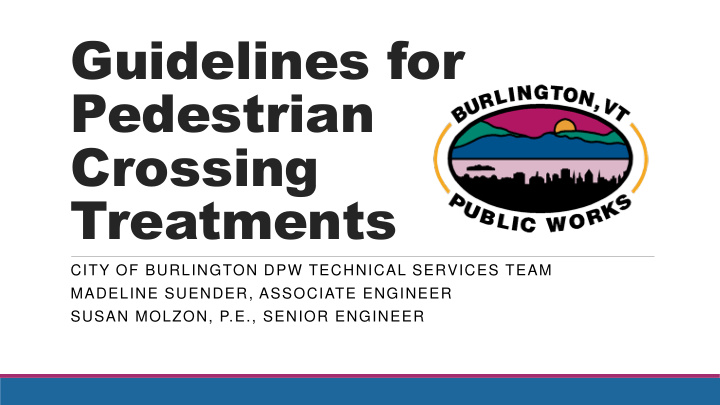



Guidelines for Pedestrian Crossing Treatments CITY OF BURLINGTON DPW TECHNICAL SERVICES TEAM MADELINE SUENDER, ASSOCIATE ENGINEER SUSAN MOLZON, P.E., SENIOR ENGINEER
Location N Champlain between Cedar and Poplar Across Flynn at Foster S Willard – midblock near Tower Terrace (by Champlain College) Introduction Across S Willard at Buell Barrett midblock East Ave midblock (Bilodeau) Battery St midblock (Monroe) Pine St. Brewery (Zero Gravity/Queen City) Across Pine St. at Sears Ln - 28 Crosswalk Requests in queue Across Pine St at Howard Across Ethan Allen Pkwy at Farrington Across South Union at Bradley St - City of Burlington needs supplemental Across St Paul at Adams guidance to safely install crosswalks Across Pearl at George St Across Main at Summit St - Midblock crossings Across Archibald at Walnut - Crosswalk enhancements Across Colchester at Chase Across Flynn at Wells 62 Oak St Across Pine at Ferguson Across Pine at Lyman Allen and Murray Intersection Wells and Ferguson Intersection Ferguson and Richardson Intersection Across Locust St at Locust Terrace S Prospect (at Waterman) Shelburne St between Prospect and the Rotary North St between Blodgett and Front St
Burlington Crosswalk Treatment Calculator - Calculates VTrans Treatment - Guidelines for Pedestrian Crossing Treatments - Calculates NCHRP Treatment - Report 562: Improving Pedestrian Safety at Unsignalized Crossings - Referenced by NACTO - Sponsored by AASHTO and FHWA
Data Sources - Vehicle Speed ◦ Posted Speed, CCRPC - Peak Hour Vehicle Volume ◦ CCRPC, VTrans - Peak Hour Pedestrian Volume ◦ CCRPC, VTrans - Pedestrian Crossing Distance VTrans Burlington Guidelines Guidelines Vehicle Speed AADT (veh/day) Peak Hour Vehicle Volume (veh/hr) Peak Hour Pedestrian Volume (ped/hr) Number of Lanes Crossing Distance
Step 1: VTrans Requirements Consideration of applicable VTrans specific requirements: - Proximity to another crosswalk ◦ Greater than 200 ft - Minimum Stopping Sight Distance ◦ Greater than 155 ft
Step 2: Minimum Pedestrian Volumes - Peak Pedestrian Volume ◦ Minimum of 20 pedestrians during the peak hour ◦ Special consideration for elderly and school aged children per VTrans requirements - Peak Hour Traffic Volume considered
Step 3: Warrant for a Traffic Signal - MUTCD Section 4.C.05 Warrant 4, Pedestrian Volume
Step 4: Estimate Pedestrian Delay - Crossing Distance, L Equations from 2010 Highway Capacity Manual used to estimate pedestrian - Walking Speed, 𝑇 𝑞 delay: - Start up time and end clearance time, 𝑢 𝑡 - Critical gap, 𝑢 𝑑 = 𝑀/𝑇 𝑞 - Consideration of median island - Road volume of approach being crossed, v 𝑓 𝑤𝑢 𝑑 −𝑤𝑢 𝑑 −1 - Average pedestrian delay, 𝑒 𝑞 = 𝑤 𝑒 𝑞 −𝑤 𝑞 - Total pedestrian delay, 𝐸 𝑞 = 3600
Step 5: Treatment Selection Crosswalk: This category encompasses standard crosswalk markings and pedestrian crossing signs, as opposed to unmarked crossings. Enhanced: This category includes those devices that enhance the visibility of the crossing location and pedestrians waiting to cross. Warning signs, markings, or beacons in this category are present or active at the crossing location at all times. Active: Also called “active when present,” this category includes those devices designed to display a warning only when pedestrians are present or crossing the street. Red: This category includes those devices that display a circular red indication (signal or beacon) to motorists at the pedestrian location. Signal: This category pertains to traffic control signals.
VTrans Comparison VTrans Requirements Unit User Field STREET NAME: Is there another crosswalk within 200 ft? Yes/No Minimum Stopping Sight Distance of 155 ft? Yes/No AADT veh/d Marked Crosswalk alone may be appropriate Number of Lanes Treatment Category Additional enhancements should be included Treatment Type to consider Additional crosswalk enhancements must be included, a marked crosswalk alone is not appropriate 3,000 ≤ vpd < 9000 vpd 9,000 ≤ vpd < 12,000 vpd ≥ 12,000 vpd Roadway configuration ≤ 30 mph ≤ 30 mph ≤ 30 mph In-street pedestrian crossing sign In-street pedestrian crossing sign, RRFB In-street pedestrian crossing sign, RRFB 2 Pedestrian refuge island, RRFB, Advanced Pedestrian refuge island, RRFB, Advanced Yield Pedestrian refuge island Yield Line and required regulatory signs 3 Line and required regulatory signs Advanced Yield Line and required RRFB, Advanced Yield Line and required RRFB, Advanced Yield Line and required 4+ (with raised median) regulatory signs regulatory signs regulatory signs 4+ (without raised median) Pedestrian Refuge Island, Advanced Yield Advanced Yield Line and required regulatory Pedestrian Refuge Island, Advanced Yield Line and required regulatory signs signs, RRFB Line and required regulatory signs, RRFB Derived from Figures 10 and 11 of VTrans Guidelines for Pedestrian Crossing Treatments
Conclusion Using both NCHRP and VTrans guidance, the City can install safe crosswalks and crosswalk treatments based on readily available data.
Links VTrans Guidelines: https://vtrans.vermont.gov/sites/aot/files/highway/documents/ltf/Crossing%20Treatment%20Guidelines%20January_20 15.pdf VTrans Transportation Data Management System: https://vtrans.ms2soft.com/tcds/tsearch.asp?loc=Vtrans&mod= NCHRP Report: https://nacto.org/wp-content/uploads/2010/08/NCHRP-562-Improving-Pedestrian-Safety-at-Unsignalized-Crossings.pdf MUTCD Warrant: https://mutcd.fhwa.dot.gov/htm/2009/part4/part4c.htm
Crosswalk This category encompasses standard crosswalk markings and pedestrian crossing signs, as opposed to unmarked crossings.
Enhanced This category includes those devices that enhance the visibility of the crossing location and pedestrians waiting to cross. Warning signs, markings, or beacons in this category are present or active at the crossing location at all times.
Active Also called “active when present,” this category includes those devices designed to display a warning only when pedestrians are present or crossing the street.
Red This category includes those devices that display a circular red indication (signal or beacon) to motorists at the pedestrian location.
Signal This category pertains to traffic control signals.
Recommend
More recommend